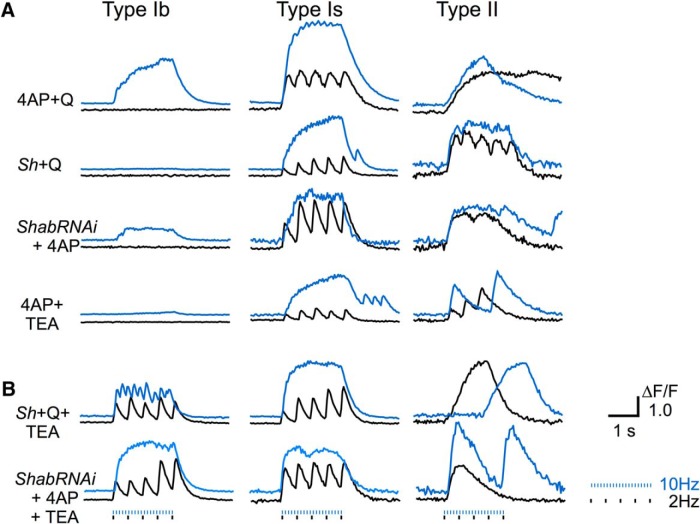Figure 6.
Extreme excitability indicated by single pulse-evoked giant GCaMP signals: double and triple insults of combined mutation and drug effects. GCaMP6m signals (ΔF/F) in response to 2-Hz (black) and10-Hz (blue) stimulation from larvae carrying the nSyb-GCaMP6m construct (0.1 mM Ca2+). nSyb-GCaMP6m, used as WT control (0.1 mM Ca2+), examined by coapplication A, Double insults of combined effects of 4-AP (200 µM) + quinidine (Q, 20 µM), ShM + quinidine (20 µM), ShabRNAi + 4-AP (200 µM), and 4-AP (200 µM) + TEA (10 mM). Note the robust GCaMP signals in type II and Is synapses evoked by individual stimuli (2 Hz) and the preferential response of type Ib synapses to combined insults of 4-AP + Q or ShabRNAi (10 Hz). B, Triple insults of K+ channel perturbations with ShM + Q (20 µM) + TEA (10 mM), or ShabRNAi + 4-AP (200 µM) + TEA (10 mM). Note the single pulse-evoked giant GCaMP signals in type Ib synapses (2 Hz), indicating a state near the ceiling effect of hyperexcitability. Also note that hyperexcitability resulted in interrupted, aborted or rebounding GCaMP signals in type II synapses (2 and 10 Hz) and rebounds of type Is responses (10 Hz). Based on observations from three to five larvae for each condition.

